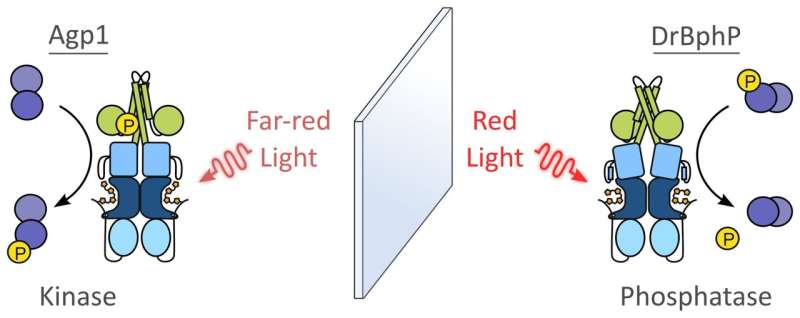New insights into bacterial photoreceptors: Similar structures, opposing functions

Sunlight influences an array of biochemical processes in plants, animals, fungi, and bacteria. In numerous organisms, phytochromes—a special class of photoreceptors—absorb red or far-red light and transform it into signals that trigger corresponding physiological reactions. In Nature Communications, an international team including scientists from Bayreuth has now reported a surprising discovery: two bacterial phytochromes function in contrasting ways despite having a similar structure. These findings offer new starting points for research into light-controlled processes in nature and for biotechnological applications.
In bacteria, the influence of sunlight on the organism is often controlled by signaling systems that involve two components. The first component is a photoreceptor, often a phytochrome. Like molecular switches, phytochromes switch back and forth between two states in which they absorb red or far-red light. In this way, they trigger biochemical signals that are passed on to the second component of the system, the response regulator. The response regulator, in turn, triggers certain biochemical processes—including the expression of genes—in the bacteria, depending on the type and intensity of the signals.
Normally, bacterial phytochromes function as enzymes that transfer phosphate groups to protein molecules. These enzymes are also called kinases. But in the phytochrome of the bacterium Deinococcus radiodurans (DrBphP), which is considered an important model system in research, scientists have been searching in vain for this or other types of enzymatic activity for a good 20 years. Thus, despite its enormous relevance as a model system, the precise biological function of DrBphP remained unclear. The biochemical research group led by Prof. Dr. Andreas Möglich at the University of Bayreuth, in cooperation with research partners in Finland, has now solved this long-standing mystery. The phytochrome of the model bacterium D. radiodurans is indeed out of the ordinary: it behaves similarly to another class of enzymes that cleave phosphate groups off neighboring molecules and are therefore called phosphatases.
The researchers obtained their findings by comparing them with the phytochrome of the bacterium Agrobacterium fabrum (Agp1). This phytochrome promotes—as is characteristic for kinases—not the cleavage but the transfer of phosphate groups. "The comparison of the phytochromes originating from two different bacterial species is so exciting because they have opposing functions, although they are very similar in terms of their molecular blueprint. And we have noticed yet another conspicuous feature: the two functions are distributed, again in opposite directions, in two opposite states. The phytochrome Agp1 unfolds its kinase activity when it absorbs far-red light. Conversely, the phosphatase activity of the phytochrome DrBphP starts when it absorbs red light. Via this comparative analysis, more than twenty years after its discovery, we are now able to assign an enzymatic function to DrBphP for the first time. These findings could provide interesting starting points for optogenetics, in particular for the construction of artificial light receptors with which cellular processes can be controlled," says Prof. Möglich.
The last author of the study published in Nature Communications is Dr. Heikki Takala, Academy Research Fellow at the University of Jyväskylä in Finland and previously head of a junior research group at the University of Helsinki. In 2020, he was selected as a Senior Fellow by the University of Bayreuth Centre of International Excellence "Alexander von Humboldt." During his research stay in Bayreuth, he cooperated with Prof. Möglich's Bayreuth research group. "The collaboration in our Bayreuth team has proven very successful scientifically and has also greatly expanded my network of personal contacts. We are therefore intensifying our exchange of ideas on photobiochemistry even after the study that has now been published. The results show that in many regards we are only beginning to unravel the light control of biochemical processes. Within the context of a research stay of my colleague Elina Multamäki in Bayreuth, we will implement our new findings in a biotechnological application of the DrBphP starting in September," says Dr. Takala.
More information: Elina Multamäki et al, Comparative analysis of two paradigm bacteriophytochromes reveals opposite functionalities in two-component signaling, Nature Communications (2021). DOI: 10.1038/s41467-021-24676-7
Journal information: Nature Communications
Provided by University of Bayreuth




















